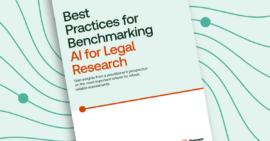
First published in 1875 and administered since inception by the Council of Law Reporting in Victoria, the Victorian Reports are now available online on Westlaw AU through a new venture between the Council, the publisher Little William Bourke and Thomson Reuters.
The new Westlaw AU online platform will boost existing website and hard-copy channels for the Victorian Reports and will include the backset reports since 1957.
Over a distinguished and diverse legal career spanning roles from associate-designate to High Court Justice Sir Ninian Stephen to over 17 years in private practice at a leading national law firm, Peter G Willis SC – current chair of the Victorian Bar’s Human Rights Committee and chair of CommBar’s Equity Section – brings a great depth of commercial and public law expertise to his new role as editor of the Victorian Reports.
In this interview, Mr Willis discusses what motivated him to take the position, the editor’s role in the selection and reporting of significant judgments of the Supreme Court of Victoria, and the value of the authorised Victorian Reports to legal practitioners in Victoria and across the country.
[pullquote align=”left” cite=”Q:”][/pullquote]
What are you looking forward to in your new role as editor of the Victorian Reports? What is the value to legal practitioners of an authorised law report?
[pullquote align=”left” cite=”A:”][/pullquote]I hope to contribute to the vitality of the report series and enhance its value to the profession. Part of the editor’s role is building the corpus of judgments available to legal professionals and students across the country. The Victorian Reports has a fantastic legacy, and one of my aims is to assist it to adapt to and flourish in the modern electronic environment. It’s important to make authorised reports available as widely as possible, and in a timely manner.
An authorised report, as opposed to more general legal reporting or a copy of the unreported judgment, is an authoritative contribution to the development of the law. It’s valuable because it has been curated – that is, selected, reviewed, carefully summarised and thoroughly revised, including by the relevant judge(s) that handed it down. When we might otherwise be drowning in a sea of individual cases, the process of selection and reporting is a marker of value.
[pullquote align=”left” cite=”Q:”][/pullquote]
What is the most important factor when selecting a case or writing a headnote?
[pullquote align=”left” cite=”A:”][/pullquote]The fact of selection is inevitable and essential when you appreciate that of the roughly 1000 decisions of the Supreme Court of Victoria each year, around 100 to 120 judgments are reported.
The selection process is rigorous and reasonably complex. The criteria for selection of cases remain as they have always been: a case that introduces a new principle or rule of law or clarifies conflicting authorities; a case that gives an authoritative interpretation of a new statute; cases on important matters of practice or procedure; and cases that, in the words of Lord Lindley, “for any reason are peculiarly instructive” (for example, that conveniently summarise or act as a refresher on a technical area of law).
In undertaking the selection process, I draw on my experience as a practitioner and as a law reporter for the Commonwealth Law Reports. I’m fortunate to have access to a broad range of senior practitioners, on whom I can call for input and assessment of cases of significance in their field, and a pool of law reporters drawn from a variety of practice areas.
Once a decision is selected, a reporter is assigned to create a headnote summarising the key elements of the decision and develop catchwords that tag the decision by reference to searchable topic categories. These are reasonably consistent across the various Australian jurisdictions. Both the decision and the headnote are then checked and approved by the judge(s) that handed it down.
[pullquote align=”left” cite=”Q:”][/pullquote]
How do the cases covered in the Victorian Reports impact other jurisdictions?
[pullquote align=”left” cite=”A:”][/pullquote]I would say increasingly. It’s a two-way street. This for two reasons: the increasing prevalence of uniform laws – not only the Corporations Act 2001 (Cth) and Australian Consumer Law, but in fields as diverse as the uniform Evidence Act, occupational health and safety laws, professional regulation – and the High Court’s direction to follow intermediate courts of appeal in other Australian jurisdictions unless plainly wrong.
Of course, while there will be laws unique to particular jurisdictions, part of the selection process involves an analysis of whether a Victorian decision discusses or refers to an interstate decision at length.
One significant benefit of the new arrangements for online publication of the Victorian Reports is that legal practitioners and students across the country will have access to authorised reports of Victorian Supreme Court cases almost as soon as the report is settled by the Court, without waiting for a printed part or bound volume. The online version will have immediate continuous pagination of the ultimately published volume.
[pullquote align=”left” cite=”Q:”][/pullquote]
As a barrister, what research materials do you regularly use? What can you not live without?
[pullquote align=”left” cite=”A:”][/pullquote]Aside from the Victorian Reports? A good electronic case citator; my online subscription to the Commonwealth Law Reports; Miller’s Australian Competition and Consumer Law Annotated, 38th Edition 2016; Odgers’ Uniform Evidence Law, 12th Edition; and the VRs.
My floor in chambers has a set of every state’s authorised reports and the Federal Court Reports, and of course we have personal and pooled collections of legal textbooks. Did I mention the Victorian Reports? Finding the relevant source of law and confirming that my understanding is up to date are the keys to providing advice and making submissions.
[pullquote align=”left” cite=”Q:”][/pullquote]
What made you go into law? If you weren’t a barrister, what career path would you have chosen? What are your most memorable achievements?
[pullquote align=”left” cite=”A:”][/pullquote]Although my father was a lawyer across the whole gamut – barrister, solicitor, corporate counsel – I took my time to find the law. I first completed a degree in history. If I weren’t a lawyer or historian, I might have been an architect.
I’ll leave ‘achievement’ to others to assess. Some of the cases that were of enduring value, in human terms, were native title consent determinations: the judgments represent the tip of the iceberg after years of negotiation and hearings (Mullett on behalf of the Gunai/Kurnai People v State of Victoria [2010] FCA 1144; Lovett on behalf of the Gunditjmara People v State of Victoria [2007] FCA 474).
Peter G Willis SC commences his role as editor of the Victorian Reports with volume 47, published from August 2016.


